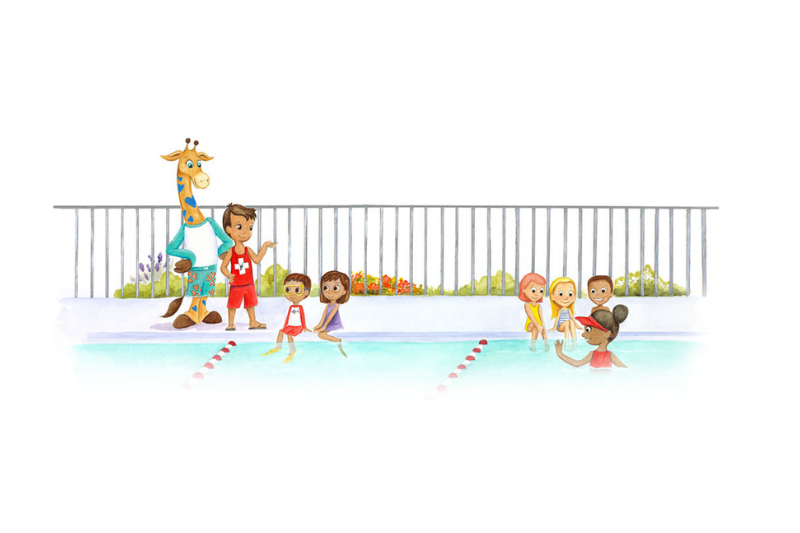Valley Children's Water Safety Program

The Valley Children’s Water Safety Program provides broad-based awareness messaging, educational opportunities and community outreach events for children and families on water safety and drowning prevention. Our multifaceted program aims to decrease water-related injuries and drowning and improve the health, safety and well-being of children in communities served by Valley Children's Healthcare.
Why is water safety and drowning prevention so important?
Drowning is the number one cause of unintentional injury and death in California for children under age 5. In the past decade, more of our youngest children died from water-related injuries than from motor vehicle crashes. Drowning is the second leading cause of death for children 0-14 years old. Every day, an average of 10 people in the United States die from drowning, 20% of them children under 14 years old.
Water Safety Tips for Your House, Yard and the Great Outdoors
- Never leave a child unattended in a bathtub, even to answer the door or phone.
- Keep toilet lids shut and use toilet locks in homes with an infant or toddler.
- When mopping floors, place the bucket in a sink if you have small children in the home that are learning to walk. They are curious by nature and want to see what is in the bucket sitting on the floor. Because they are “top heavy,” if they fall into the bucket, they will do so head first. Small children do not have the coordination to push their heads back out of the water. If there are cleaning agents in the bucket, additional complications can occur. Store buckets up and out of the reach of the small child at all times.
- Prevent children from having direct access to a swimming pool. A four-sided isolation fence surrounding the pool is the best barrier you can invest in! Having your house as the fourth side of the fence protects your neighbors but not your children unless you have additional barriers in place.
- Choose a “designated water watcher” when your children or in or near water. This supervising adult should maintain constant visual contact with children at all times, avoiding any and all distracting activities while watching the children. Change off your water watcher adult with another responsible adult every 15-30 minutes to keep those watching alert.
- Store buckets inside and out of your home as well as kiddie pools emptied and upside down. A child can drown in as little as one inch of water.
- Sprinklers have refilled emptied kiddie pools with water that have led to drowning events. Always store upside down.
- Avoid using air-filled toys as swimming support. They are not life jackets. Floating toys give a false sense of security and can significantly increase the risk of drowning. This includes water wings or “floaties.”
- Follow all posted rules and stay near a lifeguard. If you’re enjoying the day at the beach, be sure to follow all posted rules and guidelines. If you’re swimming in a location that has lifeguard(s) on duty, it’s a good idea to stick near them, and always obey their instructions. Remember: the lifeguard is not the adult supervision; that still is the role of your “water watcher.” Lifeguards are additional eyes on all those in their water space.
- Create a special water safety plan if you and your family are going to enjoy rivers or lakes. Pay close attention to the signs near these areas and follow the posted rules. These waterways may look different from year to year due to seasonal changes in rain and snow melt.
Fast Facts about Water Safety
- Drowning is usually silent, happening without a sound. There is no splashing or screaming like we see in the movies. Minutes matter when a child is submerged. Within two minutes under the water, a child will lose consciousness. Brain damage begins in brain tissue after three to five minutes without oxygen. Most children who die from a drowning event are found after being missing ten minutes or more.
- For children who survive a significant, nonfatal drowning event, the consequences can be devastating. Survivors often suffer severe and permanent lifelong neurological disability.
- The long-lasting psychological and emotional trauma of a water related incident can be prevented with active adult supervision. Watching your kids near water prevents injury. Cell phones and electronic devices are one of the biggest threats to adult supervision. It is too easy to become distracted and lose track of time while on them. A cell phone tucked away (but ready for an emergency) is the best way to provide active adult supervision around water. Your watchful eye keeps them safe.
- The majority of drownings with children under the age of 5 years in the Central Valley occur in a backyard swimming pool. For those under 5 years old, active adult supervision needs to have “touch supervision” added. The adult should be no more than one arm’s length away from the child at all times.
- Teenagers most commonly drown in rivers and lakes. Often they overestimate their swimming skills. They still need adult supervision and swim with a buddy as best practice.
- A toddler can drown at a picnic without a swimming pool or fountain in sight, simply by reaching into a plastic tub of beverages with an inch of melted ice at the bottom and falling head first into the tub.
- During the early summer months especially, snow melt from surrounding mountains in the Central Valley gives us fast running rivers and deeper lakes. Enjoy nature at its most beautiful, but keep your family safe by wearing U.S. Coast Guard approved life jackets. Click here to learn from Safe Kids Worldwide how to fit a life jacket on your child.
- Recently, the American Academy of Pediatrics (AAP) updated recommendations concerning swimming lessons for children. In this revised policy statement, the AAP now recommends water safety interventions should be based on a child’s specific developmental stage. This includes when to start your child in swimming lessons.
Be prepared to respond to a drowning by learning CPR. Adults and teenagers over age 13 can save a child’s life by immediately and effectively administering CPR. If a child is missing, look in the water FIRST. Call 9–1–1. Administer CPR.
The ABCs of Water Safety
A – Active adult supervision (include “touch supervision” if the child is under 5 years old)
B – Barriers such as pool fencing and locked doors
C – Classes such as swimming lessons and courses in CPR
Mary Jo Quintero, prehospital liaison nurse and water safety coordinator at Valley Children's Hospital, provides drowning prevention education to students and families throughout our region. To learn more about activities and resources available through the Water Safety Program, contact Mary Jo Quintero at 559-353-8661 or email her at mquintero@valleychildrens.org.
Learn More About Water Safety
For additional best practice water safety tips and resources visit:
Valley Children’s Online Health Encyclopedia
Safe Kids Worldwide
American Academy of Pediatrics
Water Safety Council of Fresno County


